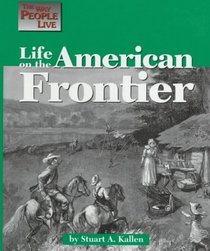PaperbackSwap.com lists this book appropriate for Reading Level: Ages 4-8. I believe this is incorrect; it should read, Reading Level: Grades 4-8. Youngsters and adults will appreciate the efforts of the author to give money comparisons: In the day when a skilled carpenter could make ~ $1.50/day, a fur trapper could make $2,000 for a seasons pelts (about 3months work).
The writing in this book bounced from the banality of an old history text to the sublime inspiration of primary sources (illustrating his point). The special aspects of this book are: money comparisons, giving costs/sales in frontier dollars, the line drawings, b&w photos and maps. A single drawing often explained more than pages of writing.
At first, I was aggravated with this book; the cover clearly illustrates pioneer life. However the book starts with the trailblazers. In other words, it gives the history of the lands west of the original colonies starting with Lewis and Clark. With each succeeding chapter, changes in the use of western lands were explained, often using the words of the Indians, trappers and miners.
Text about the gold rushes of 49 (California) and 59 (Colorado) explained just how hard it was to live and work in these conditions. The tale of the pioneers in wagons showed how arduous it was to go west; most of the people walked alongside the wagons. The prairie schooners were saved for the tons of goods they brought and allowed the smaller children, elderly and new mothers to ride.
Probably the best chapter in the book is: Native Americans on the Frontier. It shows in frightening simplicity how they were robbed of their way of life. When the Europeans killed off millions of beaver, deer, elk and buffalo (mostly for the skins the meat was left to rot), the Indians were enraged. They had always seen the animals on the land as limitless; the Europeans proved they were not. In only 20 years, they wiped out 75 MILLION buffalo.
The skin game of North America lasted for 200 years; Europeans thought pelts were the only things of value in the far-away land. The first stampede was actually for brown gold: beaver, fox, otter and marten (tree-living animals) skins. In 1760 alone, the Hudson Bay Company exported enough beaver pelts to England to make 576,000 beaver hats. This book describes the wholesale rape of the land and the effects it had on the Plains and western Indian tribes.
The strength of this book lies in the fact that the author just gives the facts. By doing so, the reader learns of the staggering injustice, prejudice and difficult lives various groups experienced in early America. Besides the Indians, the Chinese and single European ladies were victimized (ladies with no relatives in the US and not knowing the language, often wound up in prostitution there were no other jobs).
This is a thought-provoking book. 4.5 stars
The writing in this book bounced from the banality of an old history text to the sublime inspiration of primary sources (illustrating his point). The special aspects of this book are: money comparisons, giving costs/sales in frontier dollars, the line drawings, b&w photos and maps. A single drawing often explained more than pages of writing.
At first, I was aggravated with this book; the cover clearly illustrates pioneer life. However the book starts with the trailblazers. In other words, it gives the history of the lands west of the original colonies starting with Lewis and Clark. With each succeeding chapter, changes in the use of western lands were explained, often using the words of the Indians, trappers and miners.
Text about the gold rushes of 49 (California) and 59 (Colorado) explained just how hard it was to live and work in these conditions. The tale of the pioneers in wagons showed how arduous it was to go west; most of the people walked alongside the wagons. The prairie schooners were saved for the tons of goods they brought and allowed the smaller children, elderly and new mothers to ride.
Probably the best chapter in the book is: Native Americans on the Frontier. It shows in frightening simplicity how they were robbed of their way of life. When the Europeans killed off millions of beaver, deer, elk and buffalo (mostly for the skins the meat was left to rot), the Indians were enraged. They had always seen the animals on the land as limitless; the Europeans proved they were not. In only 20 years, they wiped out 75 MILLION buffalo.
The skin game of North America lasted for 200 years; Europeans thought pelts were the only things of value in the far-away land. The first stampede was actually for brown gold: beaver, fox, otter and marten (tree-living animals) skins. In 1760 alone, the Hudson Bay Company exported enough beaver pelts to England to make 576,000 beaver hats. This book describes the wholesale rape of the land and the effects it had on the Plains and western Indian tribes.
The strength of this book lies in the fact that the author just gives the facts. By doing so, the reader learns of the staggering injustice, prejudice and difficult lives various groups experienced in early America. Besides the Indians, the Chinese and single European ladies were victimized (ladies with no relatives in the US and not knowing the language, often wound up in prostitution there were no other jobs).
This is a thought-provoking book. 4.5 stars




